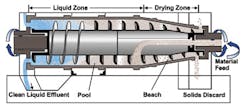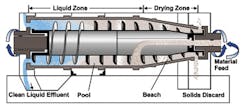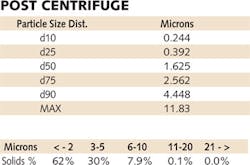North American industrial wastewater discharges are heavily regulated, and enforced with surcharges, fines, and the threat of permit rejections. Some manufacturers are modifying their production processes to produce the minimum wastewater possible, thereby reducing the volume and/or severity of treatment required downstream.
In many plants the wastewater is reused and re-circulated into other areas of the facility. There may be equipment in place to remove coarse materials, but a significant amount of solids can remain in the circulating water volume. If the solids are abrasive, the result can be expensive as instruments, pumps, right angle pipe elbows, nozzles, etc., can experience severe erosion over a brief period of time.
Some plants shut down for one month each year to repair this erosion damage as well as other annual PM work. Eliminating erosion damage, or at least reducing the erosion damage, could limit plant "down-time" and increase productivity.
One alternative is to use a decanting centrifuge in the process stream to remove abrasive solids. Centrifuges use centrifugal force to separate solids from a liquid stream.
In a typical application portrayed in the associated diagram with this article, the heavy phase (solids) are almost immediately g-forced to the outside of the chamber. They are conveyed to the right, up the Beach, and out the solids discharge ports. The liquid, which collects closer to the centrifuge centerline, travels to the left where it is finally discharged through the liquid weirs and returned to the process.
The difference in speed between the bowl (outer vessel) and the conveyor (helical interior scroll) can be adjusted to optimize the separation result. A high differential speed removes the solids quickly and is often used when the solids are very dense and plentiful, which helps to avoid packing the machine with solids and forcing a shut-down. A low differential speed is used when the specific gravity is low and cake dryness is difficult to achieve. Liquid discharge weirs and pump feed volume can also be adjusted to maximize the performance of the centrifuge.
Depending upon the contents of the feed liquid, centrifuges can handle feed stock from 3 to 12% solids and remove particles greater than 6 to 10 microns, resulting in a discharge of 24% to 50% solids.
Typical Industrial Applications
Steel Manufacturing
Decanters are used at steel plants to separate grit, slag, and other heavy solids from water waste streams. Due to the extreme abrasive characteristics of the feed stock, the centrifuges are fitted with sintered tungsten carbide wear protection, and monitored often for wear.
Down time for centrifuge re-conditioning is minimized by keeping a spare rotating assembly (bowl and conveyor unit) on site. When required, the rotating assemblies are swapped out, the repair of the worn-out rotating assembly is performed, and the reconditioned rotating assembly is returned to the site.
The centrifuges produce a cake which is transportable, and an effluent which, while not crystal clear in appearance, is essentially free of the abrasive components of the feed stock. The cost benefits of the separation include re-use of the water, reduced solids disposal cost, and reduced instrument, pump and piping repairs.
WESP Flush Line Clean-up
As with steel manufacturing, the main benefit of cleaning WESP (Wet Electro Static Precipitators) flush lines is to reduce maintenance costs. WESP's are used to clean smoke discharge from boilers used for power generation. The fuel source from the boilers can be coal, wood, or other flammables. When the fuel source is dirty, such as when wood bark is used, the cost benefits in centrifuging the flush water are extremely attractive. ROI can be realized within one year.
Conclusion
Removing solid contaminants from industrial wastewater quite often is an overwhelming undertaking full of surcharges and fees. There are several types of equipment that can help with this process, and with the proper equipment and the appropriate knowledge system operators may be able to eliminate a lot of those costs.





